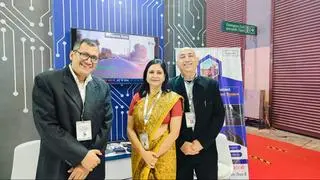In his nearly 25 years as a venture capital investor, Parag Dhol has seen many kinds of entrepreneurs and ventures. Ask him what is the difference in the entrepreneurs he is seeing now and those that he has seen over the years, without a hesitation Parag says, “one of the key differences is the ambition levels have gone up.” Entrepreneurs are now thinking big, looking for a global play, spurred in part by global VC firms that have started investing in ventures here.
The VC firms have helped entrepreneurs think big. They are ready to back the entrepreneurs to think of the global market, so much so that companies such as Ola and Oyo have entered other countries. Parag recalls a conversation he had with a young start-up founder and asking him about the confidence and comfort levels entrepreneurs now have. The entrepreneur told him that they had all grown up with the internet around them. They depended on the Net for everything and were comfortable with technology. The computing power and the number of devices have both increased. Technology exposure starts at a really young age, because of which technology has now become consumerised.
“The consumerisation of technology and ambition levels are the two things I have seen changing,” says Parag. This change is not just in consumer facing ventures; it is happening on the B2B side too. The processing power of devices has increased and connectivity is so easy for the devices. As a consequence, he says, the consumerisation of technology is happening at the enterprise kind of solutions.
Another big change over the years, according to Parag, is the teams that are sitting across the table from investors are much younger and seem to have more traction in the business.
India focus
Inventus Capital India’s focus with the third fund will continue to remain the same as the previous two funds. Except, the third fund is an India-specific one and, for the first time, it has raised domestic capital. Raising the India fund, according to Parag, is an evolution of the firm itself. Domestic capital is now available and there are some investors that want VC firms to focus on a single geography. Inventus will invest at the Series A stage in ventures, companies that are 15-30 months in their journey. It will look at a broad range of ventures – consumer internet, software as a service, IoT, machine learning, fintech – everything across the technology spectrum. It will write ₹5-15 crore initial cheques and invest up to ₹25-30 crore over multiple rounds, depending on the venture. Inventus will look to pick 15-16 per cent stake in the companies it invests in.

“One of the things that is important for us is capital efficiency. Our idea is that a company should take $30-50 million to become self-sustaining. Those are the kind of companies we like. We will take a unicorn when it comes along, but that is not what we are shooting for all the time. You will see us play the expected value where the probabilities are higher,” says Parag. Inventus believes that too much money to an entrepreneur is also not a good idea at an early stage, because the entrepreneur tends to experiment a bit too much. “Experimentation is fine, but removing all constraints is never good,” he adds.
Unlike some of its peers in the industry, Inventus believes in throwing its net wide and seeing what kind of entrepreneurs come in. “The call is on the entrepreneur at the Series A stage. That is the highest weightage for success.”








Comments
Comments have to be in English, and in full sentences. They cannot be abusive or personal. Please abide by our community guidelines for posting your comments.
We have migrated to a new commenting platform. If you are already a registered user of TheHindu Businessline and logged in, you may continue to engage with our articles. If you do not have an account please register and login to post comments. Users can access their older comments by logging into their accounts on Vuukle.